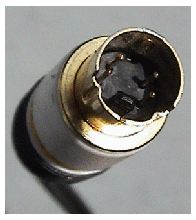
More about S-Video
Halfway between Composite Video and Component Video, S-Video is an analog video transmission standard which uses a mini-DIN connector (shown on the right) to deliver Luminance and Chrominance information on separate subchannels using a separate pin for each. S-Video signals can also be delivered using SCART connections.... (Read More)
Lines of Horizontal Resolution
Lines of Horizontal Resolution, or TV Lines, are the measure of how many changes (details) can be represented on a single analog TV scanline. The number of TV lines is limited by the source video, media, connection type, and the TV itself. The increased tape density of the videotapes and use of S-Video allow S-VHS to deliver more than half again as many TV lines as VHS, approaching broadcast quality in some cases. S-VHS VCRs are also capable of playing back standard VHS cassettes, although the only quality increase will come from the use of S-Video, and perhaps the generally better quality of S-VHS equpment vs. the more common VHS.
S-VHS-C
Like VHS, S-VHS had a corresponding compact format used for camcorders. However, as with S-VHS itself, these camcorders never caught on with the general public. They also failed to make an impact in the professional market, where Sony's Hi8 camcorders were far more popular by existing users of their Betacam format.
More about TV Lines
TV Lines are the standard measure of an analog TV's Resolution. Rather than represent discrete locations on a grid, as Pixels in a digital Frame do, TV Lines indicate the maximum number of identifiable changes that can be produced along a single (horizontal) Scanline of an analog TV.... (Read More)
S-Video and Video Capture
Even when capturing regular VHS tapes you can benefit from the S-Video connection and generally higher quality offered by a S-VHS VCR. You can often find very high quality used equipment cheap, as there's little use for it in the professional world with the dominance of digital formats.
S-VHS ET
Some S-VHS VCRs support recording near-S-VHS quality to standard VHS videotapes. With high quality VHS tapes, a significant quality increase over recording with a standard VHS VCR is possible.
Transition to Digital
Like all analog videotape technology, S-VHS has been made obsolete thanks to the dominance of digital formats for both home video and professional applications. An attempt was made by JVC to replace it with a digital standard called D-VHS, but the emergence of DVRs and DVD recorders, as well as the ability to capture DTV streams via computer has prevented D-VHS from gaining any momentum.



